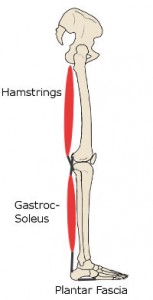Pain, often excruciating pain, is one of the most obvious symptoms of plantar fasciitis. This common condition involves the inflammation of the plantar fascia, which is the band of tissue that runs along the bottom of the foot, connecting the heel bone to the toes.¹ The pain is usually most severe when you first get out of bed, but it can persist throughout the entire day if you’re frequently on your feet.¹

Even though staying off your feet may seem like an easy answer, it’s one of the worst things you can do for plantar fasciitis.² You instead want to take action to alleviate the pain and, equally as important, address the underlying cause of the problem.
Why You Get It
The main cause of plantar fasciitis is usually an overuse injury, sometimes brought about by repetitive stress on the outside of edge of the foot that increases the tensile force on the plantar fascia and results in a lowering of your plantar arch.¹ ³ This results in the plantar fascia’s inflammation and degeneration, usually where the fascia connects to the heel bone.⁴ Those who experience plantar fasciitis in both feet simultaneously are often suffering from some type of underlying health issue, such as rheumatoid arthritis or gout.¹ Most of the time the condition erupts in a one foot or the other, typically from subjecting your feet to various factors that contribute to the condition.
People in occupations that involve a lot of standing or walking are prime candidates for plantar fasciitis, as are those who are overweight or pregnant.¹ The condition is also known to hit people who habitually wear poorly supportive, thin-soled footwear or are consistently working or playing sports on hard surfaces.¹ ²

Faulty biomechanics can also be to blame. Those with limited ankle dorsiflexion are at risk for the condition, thanks to the foot’s tendency to pronate during gait, increasing the load on the plantar fascia.¹ Pronation can increase with age, as can the reduction in the fascia’s elasticity, increasing the risk even further.³ Tightness in the posterior muscles of the lower leg has been linked to plantar fasciitis, as have tight calf and hamstring muscles.² ⁴
How to Treat it with Natural Methods and Exercise
Because plantar fasciitis is an official medical diagnosis, some may feel the need to go the medical-only route when it comes to treatment. While surgery and other medical solutions are available, you can also opt for a number of simpler, natural methods and exercise. In fact, one study showed that plantar fasciitis patients treated with a manual physical therapy and exercise approach enjoyed superior results over those treated with an approach that used electrophysical agents and exercise.⁵
Effective physical therapy strategies have included various stretches focused on the tendoachilles and plantar fascia along with whirlpool or ultrasound treatments.¹ Stretching of the hamstrings, calves and posterior muscle chain can also help, due to their ability to target the muscles that are contributing to the condition. Another study found that infrared rays, such as those utilized in infrared sauna treatments, were safe, easy to use and effective for plantar fasciitis treatment.⁶
Exercise programs, such as a regular Pilates and Foundation Training practice, can help achieve and maintain the muscular flexibility and strength that adds another layer of relief and recovery. Both programs focus on the posterior muscle chain in slightly different ways, helping to ensure it can serve as a strong foundation for optimum movement and function.
References
-
Healey K, Chen K. Plantar Fasciitis: Current Diagnostic Modalities and Treatments. Clin Podiatr Med Surg. 2010;27:369-380.
-
Orchard J. Plantar fasciitis. BMJ. 2012;345:1-12.
-
Yi T, Lee G, Seo I, Huh W, Yoon T, Kim B. Clinical Characteristics of the Causes of Plantar Heel Pain. Ann Rehabil Med. 2011; 35:507-513.
-
Labovitz J, Yu J, Kim C. The Role of Hamstring Tightness in Plantar Fasciitis. Foot Ankle Spec. 2011;4:141-144.
-
Cleland J, Abbott JH, Kidd MO, Stockwell S, Cheney S, Gerrard DF, et al. Manual Physical Therapy and Exercise Versus Electrophysical Agents and Exercise in the Management of Plantar Heel Pain: A Multicenter Randomized Clinical Trial. J Orthop Sports Phys Ther. 2009;39(8):573-586.
-
Reeboonlap N, Satismithpong N, Phisitkul P, Charakorn K. Outcome of Plantar Fasciitis Treatment Using Monochrome Infrared Irradiation. J Med Assoc. Thai. 2012;95(10):147-150.
